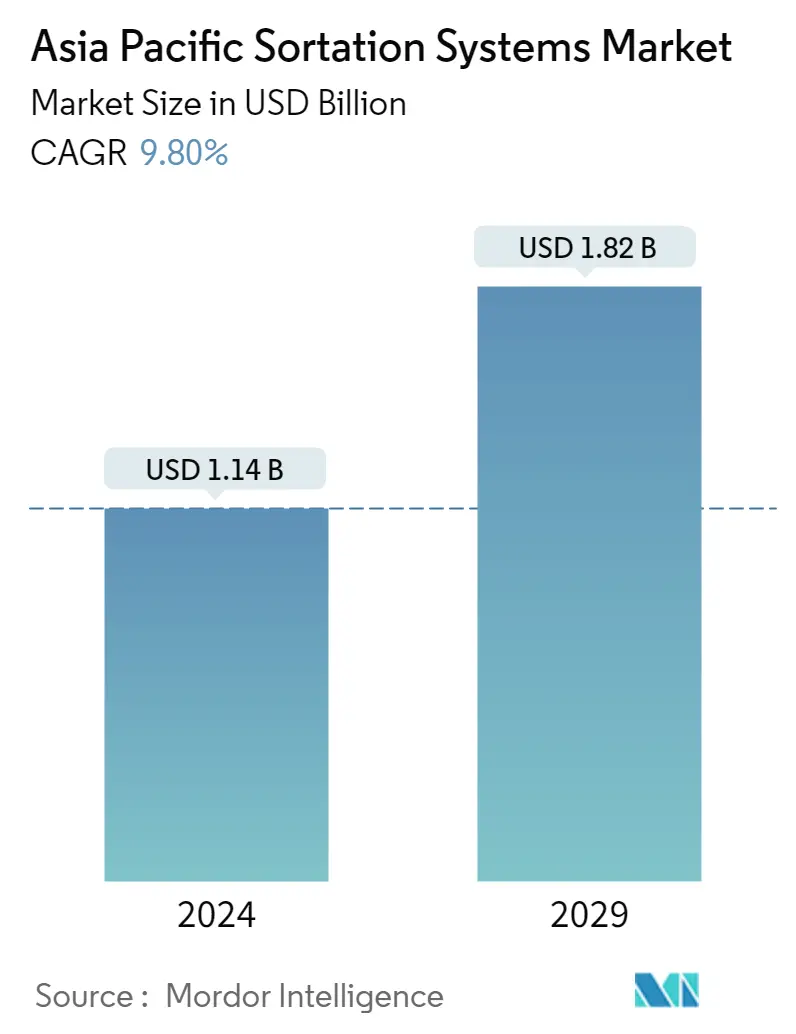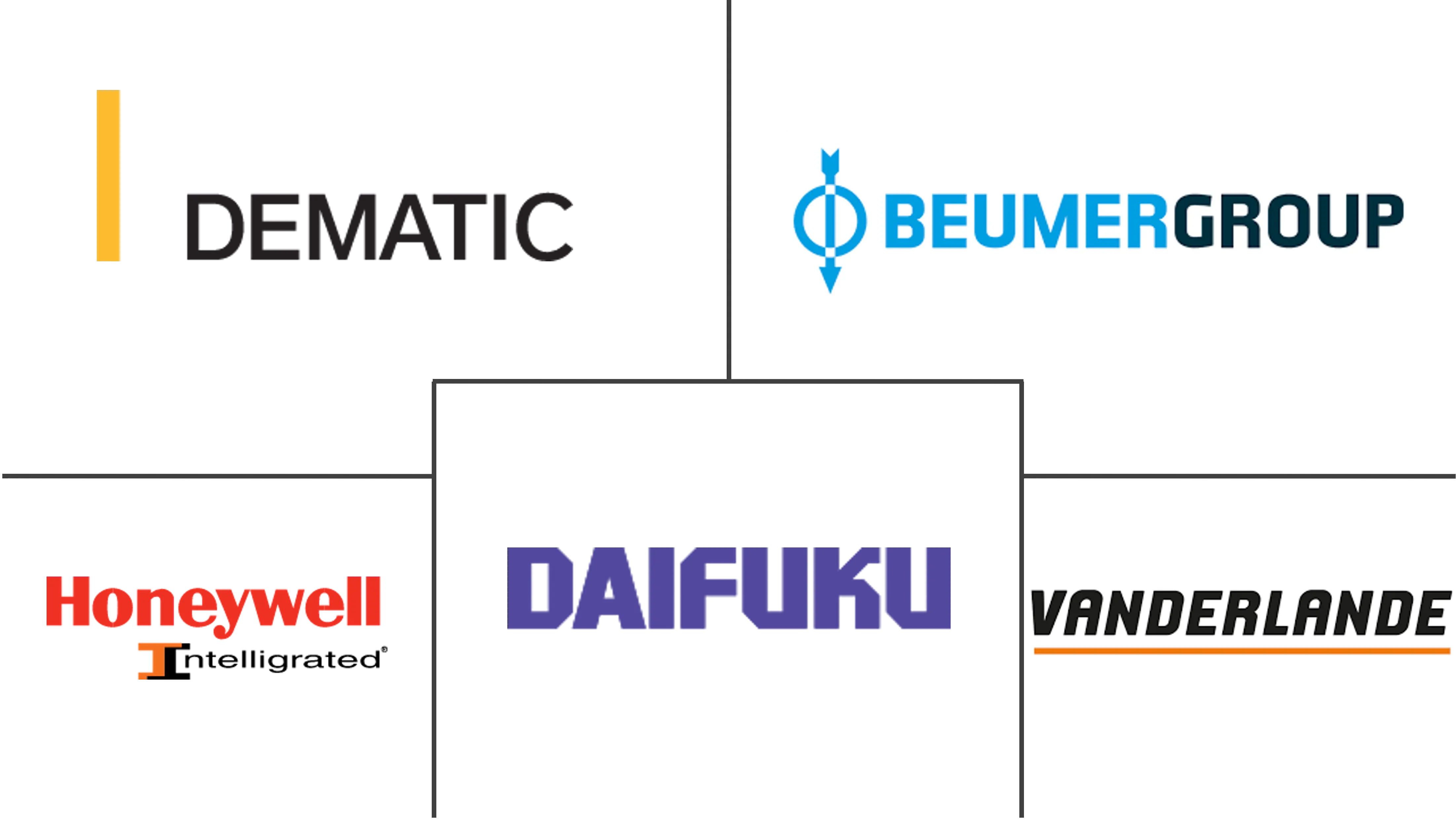Market Size of Asia Pacific Sortation Systems Industry

| Study Period | 2019 - 2029 |
| Base Year For Estimation | 2023 |
| Market Size (2024) | USD 1.14 Billion |
| Market Size (2029) | USD 1.82 Billion |
| CAGR (2024 - 2029) | 9.80 % |
| Market Concentration | Low |
Major Players
*Disclaimer: Major Players sorted in no particular order |
Asia Pacific Sortation Systems Market Analysis
The Asia Pacific Sortation Systems Market size is estimated at USD 1.14 billion in 2024, and is expected to reach USD 1.82 billion by 2029, growing at a CAGR of 9.80% during the forecast period (2024-2029).
The warehouse sector has changed tremendously over the years, from unorganized godown structures to being recognized as a prominent asset class. In the APAC region, the rising wave of consumerism has moved beyond tier-1 markets and is evident in tier 2 & 3 cities, due to increased internet penetration, rising disposable incomes, a young and educated population, and a desire for a higher standard of living. As a result, businesses are moving closer to consumption centers to ensure rapid deliveries to end-users, and in-city warehouse space is gaining importance.
- Digitalization and automation have revolutionized the logistics and warehousing industry, and warehouse inventory management has become even more critical to improving efficiencies, staying competitive, and achieving customer satisfaction. Technologies such as radio frequency identification (RFID) are crucial in warehouses, as they help redesign fundamental warehouse functions to achieve the best outcomes.
- There is an increasing demand for international brands and foreign products among Indian online buyers, creating a significant demand for automated warehouses to handle the increased inflow of parcel volumes. According to Flipkart's 'How India Shops Online 2021' report, the e-retail market is expected to grow to USD 120-140 billion by 2026.
- Furthermore, in July 2023, Hong Kong Post and Geek+ have partnered to implement its robotic packet sorting system. Combining Geek+'s advanced sorting and moving solutions with the development blueprint of the Hong Kong Post project team, the new technology has the potential to transform and streamline the packet sorting process to improve the efficiency of mail handling.
- Moreover, November 2023, Chinese mobile robotics company Libiao Robotics has partnered with Pos Indonesia (Pos Ind) to offer a custom robotic sortation solution. The company has provided robots in orange rather than its standard yellow, with the deployment intended to assist Pos Indonesia in improving its order fulfillment capacity and efficiency throughout site operations.
- The COVID-19 pandemic showcased the fragility of manual processes. Many organizations experiencing labor shortages turned to warehouse automation. The pandemic resulted in the improvisation of the supply chain with last-mile delivery, in-city distribution, and various other hybrid models. Companies that invested in automation grew revenue and profitability despite the shutdowns. The increasing availability of tools and techniques has lowered the barriers to entry for companies that may have thought automation solutions were out of reach.
- Warehouses with parcel sortation systems have to process significant order volumes. However, a mixture of different packaging sizes and structures causes significant problems for conveyor and other parcel-sorting technologies regarding the precision, speed, and quality of packaging sortation.
Asia Pacific Sortation Systems Industry Segmentation
Sorting systems are material handling systems used to sort items in warehouses or distribution centers. Sortation systems are the most efficient and productive automated material handling systems used in demanding e-commerce, post and parcel, and wholesale distribution operations. These systems help increase productivity for operations and decrease labor costs because they eliminate the need to hire many people. Automatic sorters range from conveyor-based sorters like the cross-track sorter to carrier-based sorters.
The Asia Pacific sortation systems market is segmented by end-user (post and parcel, airport, food, and beverages, retail, and pharmaceuticals) and geography (China, Japan, Thailand, India, Singapore, Malaysia, Taiwan, and South Korea). The report offers market forecasts and size in value (USD) for all the above segments.
| By End-User | |
| Post and Parcel | |
| Airport | |
| Food and Beverages | |
| Retail | |
| Pharmaceuticals |
| By Country | |
| China | |
| India | |
| Indonesia | |
| Japan | |
| Malaysia | |
| Singapore | |
| South Korea | |
| Taiwan | |
| Thailand |
Asia Pacific Sortation Systems Market Size Summary
The Asia Pacific sortation systems market is experiencing significant growth, driven by the region's rapid industrialization and the increasing demand for efficient logistics solutions. As consumerism expands beyond major urban centers, businesses are investing in automated sortation systems to enhance their warehousing capabilities and meet the rising expectations for quick and reliable deliveries. The shift towards digitalization and automation in logistics is reshaping the industry, with technologies like RFID playing a crucial role in optimizing warehouse operations. The COVID-19 pandemic further accelerated this trend, highlighting the need for automation to overcome labor shortages and improve supply chain resilience. As a result, the market is becoming increasingly competitive, with numerous players offering innovative hardware and software solutions to capture a larger share of the growing demand.
The market's expansion is also fueled by the burgeoning e-commerce sector in the Asia Pacific region, where cross-border package deliveries are on the rise. Companies are investing heavily in automated sortation technologies to streamline their operations and handle the increasing volume of parcels efficiently. Strategic partnerships and investments in advanced sorting systems are becoming commonplace, as seen in collaborations between logistics firms and technology providers. The region's favorable economic conditions, such as low labor costs and high adoption rates of Industry 4.0 technologies, make it an attractive hub for manufacturing and logistics operations. As the market continues to evolve, it presents significant opportunities for growth, driven by the ongoing demand for automation and the need for efficient logistics solutions in the face of rising consumer expectations.
Asia Pacific Sortation Systems Market Size - Table of Contents
-
1. MARKET INSIGHTS
-
1.1 Market Overview
-
1.2 Industry Attractiveness - Porter's Five Forces Analysis
-
1.2.1 Threat of New Entrants
-
1.2.2 Bargaining Power of Buyers
-
1.2.3 Bargaining Power of Suppliers
-
1.2.4 Threat of Substitute Products
-
1.2.5 Intensity of Competitive Rivalry
-
-
1.3 Value Chain Analysis
-
1.4 Assessment of Impact of COVID-19 on the Industry
-
-
2. MARKET SEGMENTATION
-
2.1 By End-User
-
2.1.1 Post and Parcel
-
2.1.2 Airport
-
2.1.3 Food and Beverages
-
2.1.4 Retail
-
2.1.5 Pharmaceuticals
-
-
2.2 By Country
-
2.2.1 China
-
2.2.2 India
-
2.2.3 Indonesia
-
2.2.4 Japan
-
2.2.5 Malaysia
-
2.2.6 Singapore
-
2.2.7 South Korea
-
2.2.8 Taiwan
-
2.2.9 Thailand
-
-
Asia Pacific Sortation Systems Market Size FAQs
How big is the Asia Pacific Sortation Systems Market?
The Asia Pacific Sortation Systems Market size is expected to reach USD 1.14 billion in 2024 and grow at a CAGR of 9.80% to reach USD 1.82 billion by 2029.
What is the current Asia Pacific Sortation Systems Market size?
In 2024, the Asia Pacific Sortation Systems Market size is expected to reach USD 1.14 billion.

